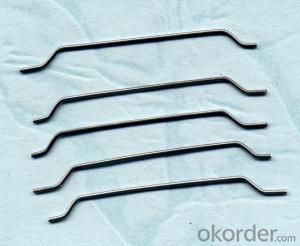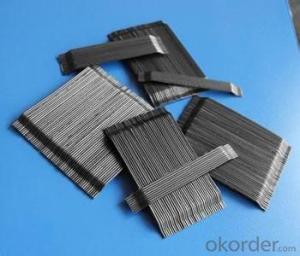Melt Extract Stainless Steel Fiber Loose Glued for Concrete Reinforcement
- Loading Port:
- Tianjin
- Payment Terms:
- TT OR LC
- Min Order Qty:
- 5 kg
- Supply Capability:
- 30000 kg/month
OKorder Service Pledge
OKorder Financial Service
You Might Also Like
Quick Details
Place of Origin: Jiangsu, China (Mainland)
Model Number: HT-MC
Material: Color Steel
certificated: ISO 9001
Specifications
ISO 9001 certificated
2.70% for Europe, Middle Asia, America market
3.Have the most number of steel fiber machine in china
1. Material: low carbon steel wire or stainless steel
2.Diameter: 0.4mm-1.0mm
3.Length: meet your requirements
4.tensile strength >1000Mpa
6.Feature: excellent tensile,high tenacity,against cracking,impact and fatigue
7.Uses: highway road surface,tunnel,building,airport road surface and so on .
Straight Steel Fiber
Low carbon steel fiber for building construction
GLUED steel fiber:
1.Diameter:0.4mm-1.2mm
2.Length: 25mm-60mm
3.Material: low carbon steel wire
4.Feature: 1100Mpa , excellent tensile,high tenacity,against cracking,impact and fatigue
5.Uses: highway road surface,tunnel,building,airport road surface and so on .
Picture
Steel fiber



FAQ
certificated: ISO 9001
Technical advantages of Daye steel fiber:
A. Improve mechanical performance of concrete
B. Provide uniform distribution throughout concrete with excellent mixing
C. No balling or caking by adopt correct mixing method
D. Reduce concrete volume
E.Save construction time and cost
F.Reduce excavation volume
G.Available for jointless floor.
- Q: How does melt extract stainless steel fiber improve the resistance to abrasion in concrete?
- Melt extract stainless steel fiber improves the resistance to abrasion in concrete by reinforcing the matrix and enhancing the overall durability of the material. The fibers are uniformly distributed throughout the concrete, which helps to distribute the impact and stress caused by abrasion. This reinforcement prevents the formation of cracks, reduces surface wear, and improves the concrete's ability to withstand abrasion over time.
- Q: What is a steel fiber cement?
- Ordinary concrete adds steel fibers to it, which is resistant to compression, bending and tensile
- Q: Can melt extract stainless steel fiber be used in tunnel shotcrete lining applications?
- Yes, melt extract stainless steel fiber can be used in tunnel shotcrete lining applications. This type of fiber is known for its high strength, durability, and resistance to corrosion, making it suitable for reinforcing tunnel shotcrete structures.
- Q: Can melt extract stainless steel fiber be used in airport runway construction?
- Indeed, melt extract stainless steel fiber is applicable for utilization in the construction of airport runways. Renowned for its remarkable strength and durability, stainless steel fiber proves to be an ideal choice for demanding tasks such as airport runways. By offering reinforcement and diminishing cracking, it significantly enhances the overall performance and lifespan of the runway. Moreover, stainless steel fibers exhibit exceptional resistance to corrosion, a vital attribute for enduring the harsh environmental conditions encountered in airport settings. Furthermore, the incorporation of stainless steel fibers aids in elevating the skid resistance of the runway surface, guaranteeing safer landings and takeoffs for aircraft.
- Q: Can melt extract stainless steel fiber be used in tunnel construction?
- Yes, melt extract stainless steel fiber can be used in tunnel construction. It is commonly used as a reinforcement material in concrete to enhance its strength, durability, and resistance to cracking. Stainless steel fibers can effectively control shrinkage cracks and improve the overall performance of the tunnel structure.
- Q: How does melt extract stainless steel fiber improve the toughness of shotcrete?
- Melt extract stainless steel fiber improves the toughness of shotcrete primarily through its reinforcing properties. When added to the shotcrete mix, these fibers create a three-dimensional network within the concrete, enhancing its overall strength and durability. The stainless steel fibers act as tiny reinforcements, dispersing throughout the shotcrete matrix and forming a strong bond with the surrounding concrete. This bond helps to distribute stress and strain more evenly, preventing cracking and enhancing the overall toughness of the shotcrete. Additionally, the high tensile strength of stainless steel fibers adds an extra layer of reinforcement to the shotcrete. This means that when subjected to external forces or impacts, the fibers help to resist deformation and maintain the structural integrity of the shotcrete. Moreover, the melt extract stainless steel fibers also improve the post-cracking behavior of shotcrete. Unlike traditional reinforcement methods, such as steel bars or mesh, which provide limited support after cracking, the fibers continue to provide reinforcement even after the shotcrete has cracked. This significantly improves the resistance to cracking propagation and prevents further damage. Furthermore, the stainless steel fibers also enhance the ductility of the shotcrete. This means that the shotcrete can undergo deformation without fracturing, allowing it to better withstand movements and settling of the underlying soil or structure. In summary, melt extract stainless steel fiber improves the toughness of shotcrete by reinforcing the concrete matrix, distributing stress, resisting deformation, improving post-cracking behavior, and enhancing ductility. These properties make shotcrete with stainless steel fibers a more reliable and durable construction material for various applications, such as tunnels, underground structures, and slope stabilization.
- Q: Can melt extract stainless steel fiber be used in tunnel segmental lining?
- Definitely! The utilization of melt extract stainless steel fiber is applicable for tunnel segmental lining. The incorporation of stainless steel fiber into tunnel segmental lining presents numerous advantages. Firstly, it reinforces the tensile strength and durability of the tunnel lining, which is crucial for maintaining the structural integrity and longevity of the tunnel. Secondly, stainless steel fibers exhibit exceptional resistance to corrosion, making them an ideal choice for underground environments with frequent exposure to moisture and chemicals. Furthermore, the utilization of stainless steel fibers aids in reducing cracking and enhancing the overall performance of the tunnel lining by boosting its resistance against shrinkage, thermal expansion, and other potential deformations. Consequently, melt extract stainless steel fiber proves to be a suitable option for tunnel segmental lining applications.
- Q: What is the effect of melt extract stainless steel fiber on the toughness of concrete?
- The addition of melt extract stainless steel fiber to concrete can have a positive effect on its toughness. Stainless steel fibers are typically used as reinforcement in concrete to enhance its mechanical properties, including toughness. When incorporated into concrete, these fibers act as tiny reinforcements, helping to distribute stress and prevent cracking. This reinforcement improves the overall toughness of the concrete, making it more resistant to impacts, vibrations, and other external forces. The melt extract stainless steel fibers are particularly effective in enhancing toughness due to their superior strength and durability. They are resistant to corrosion, which ensures their long-term effectiveness in concrete structures. Additionally, their small size and high aspect ratio allow for a better bond between the fibers and the surrounding matrix, further improving the overall toughness of the concrete. Overall, the addition of melt extract stainless steel fiber to concrete leads to an increase in its toughness, making it more resilient and durable. This can be particularly beneficial in applications where concrete is subjected to heavy loads, dynamic forces, or harsh environmental conditions.
- Q: Can melt extract stainless steel fiber be used in underwater concrete applications?
- Indeed, melt extract stainless steel fiber proves to be applicable in underwater concrete scenarios. Renowned for their exceptional tensile strength, resistance to corrosion, and long-lasting nature, melt extract stainless steel fibers are versatile enough to be employed in several applications, including underwater concrete projects. The inclusion of these fibers in concrete significantly improves its mechanical attributes, such as flexural strength, impact resistance, and crack prevention. Moreover, the corrosion-resistant nature of stainless steel fibers guarantees the durability of the concrete even in challenging underwater conditions. Consequently, opting for melt extract stainless steel fiber emerges as an ideal selection for reinforcing underwater concrete structures.
- Q: Can melt extract stainless steel fiber be used in asphalt reinforcement?
- Indeed, asphalt reinforcement can be achieved by utilizing melt-extract stainless steel fiber. To enhance the mechanical properties and resist cracking and fatigue, stainless steel fibers are commonly incorporated into asphalt mixtures. These fibers are typically derived from stainless steel materials through the process of melt extraction, resulting in a reinforcing element that is both highly strong and resistant to corrosion. The addition of stainless steel fibers to asphalt can bolster its tensile strength, flexibility, and durability, rendering it more resistant to distress such as rutting and cracking. Moreover, the integration of stainless steel fibers can also diminish the need for maintenance and repairs, thus prolonging the lifespan of the asphalt pavement. Consequently, melt extract stainless steel fiber presents a viable choice for asphalt reinforcement, offering a multitude of advantages in terms of performance and longevity.
Send your message to us
Melt Extract Stainless Steel Fiber Loose Glued for Concrete Reinforcement
- Loading Port:
- Tianjin
- Payment Terms:
- TT OR LC
- Min Order Qty:
- 5 kg
- Supply Capability:
- 30000 kg/month
OKorder Service Pledge
OKorder Financial Service
Similar products
Hot products
Hot Searches
Related keywords




























